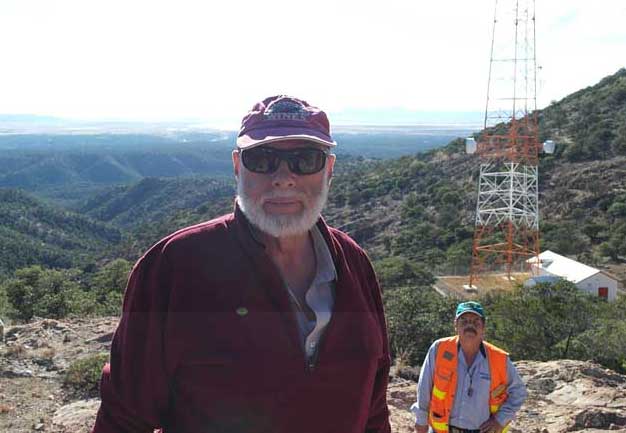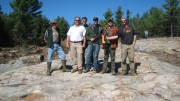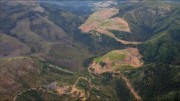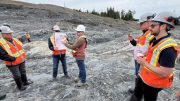CHIHUAHUA STATE, MEXICO — The green foothills an hour west of the city of Chihuahua are peaceful now. There is nothing in the gaze of a lingering llama that would tip a visitor off to the blood spilled here roughly a hundred years ago.
Indeed, the only sounds at the base of La Bufa mountain are the muffled clang of machinery from deep inside the mountain and the subdued bustle of workers at the mining camp — the typical sounds of honest silver mining.
A century ago, however, it was gunshots and stampeding horse hoofs that rang off the mountain face as Pancho Villa, Mexico’s most famed revolutionary, beat a retreat up into the safety of the mountain’s steeps.
After losing the town of Cusihuiriachic just down the road, which he had seized only days before from his rival and former ally Venustiano Carranza, Villa and his men took the mine in the mountain as both consolation and refuge.
The history books make no mention of Villa’s mining prowess during the time that he controlled the operation, but his exploits ensure that even in a place with as rich a mining history as Mexico, the Cusi mine is more intimately tied to the country’s coming of age than any other.
Thomas Robyn, Sierra Metals’ (TSX: SMT; TSXV: SMT; US-OTC: DBEXF) vice-president of exploration, is well aware of the mine’s past. The 32-year mining veteran, who has experience at mines around the globe, is now charged with turning all of that plomo in Cusi’s past into the plata of the future (plomo being the Spanish word for lead, and plata the word for silver).
Sierra first arrived here back in 2006, and at the beginning of last year it took a big step towards erasing any lingering revolutionary associations with the Cusi brand by bringing the mine into commercial production. It was the latest chapter in a story filled with alternating fits of activity and years of dormancy since Cusi was discovered by Spaniard Antonio Rodriguez in 1687.
While Sierra’s path to taking silver from these mountains wasn’t as notorious as Villa’s, it still split from convention in its own more modest way.
“We broke the rule book, we did it the way the old boys did it,” Robyn says of Sierra’s method of getting to production first and proving up resources later.
It’s a theme that ripples through the company, emphasizing a drive to get the cash first and sort out the academic details later.
The same philosophy fuelled its $300-million acquisition of the producing Yauricocha mine in Peru during 2011 — an asset that Sierra’s management team (then under the banner of Dia Bras) realized could generate enough cash to drive exploration and development at its two Mexican assets.
The capital flows also corrected a glaring inefficiency in that emerging portfolio: originally ore from Sierra’s other key Mexican project, Bolivar, was being carried by rail over 380 km to the Malpaso mill, a plant just 37 km away from Cusi.
Sierra’s president and CEO Daniel Tellechea chuckles about the old set-up, calling it “madness.” He can laugh now knowing the situation has been corrected, with the a new mill 5 km from the Bolivar mine, and Cusi’s ore now feeding the nearby Malpaso mill.
But Sierra’s experience at Bolivar isn’t only a testament to its ability to iron-out inefficiencies — it is also a template for what will unfold at Cusi.
“Bolivar was inactive for eight years,” Robyn says. “When we started with a pilot mine we had zero mine plan and zero resources. We did it for five years and got the cash we needed, and it will be the same thing with Cusi. We raised $10 million and started mining with no mine plan and no resources.”
But there is a downside to doing it the old way: namely that it can mean the Street is slow to pick up on the story.
“We were milling from Bolivar, but only one out of ten analysts really got what we were doing,” he says. “The rest weren’t really interested because of the small levels of production at the time.”
Since then the steady build-up of its production profile is making it harder for analysts and investors to turn a blind eye to Sierra’s ability to do what so many other juniors merely talk about doing: producing ounces and pounds.
Its Yauricocha mine in Peru produced 1.87 million oz. silver last year, along with 6.5 million lb. copper, 37.1 million lb. lead and 50.8 million lb. zinc. At Bolivar the mine went from milling just 300 tonnes per day five years ago up to the 2,000 tonnes today. Last year the mine turned out 9.4 million lb. copper, 930,000 lb. zinc and 270,610 oz. silver.
And that brings us to Cusi. While the mine contributed 423,089 oz. silver and 902,000 lb. lead to its totals, Sierra believes it has much more to give.
Robyn, for one, says Cusi has the most exploration upside of the three mines — whether the Street gets it or not.
“People always want to put us into a fixed template,” Robyn continues. “But it just never quite fits.”
A property teeming with potential
The first thing that is striking about Cusi is its amount of prospective zones.
Standing atop La Bufa, Robyn stretches out his hand and motions over the 120 sq. km of concessions Sierra holds. Within that expanse it is focusing on seven zones. Starting from the northern part of its property boundary and moving in a southerly direction, the first zone encountered is San Juan, then Promontorio, followed by La Minerva, Santa Eduwiges, Candelaria and lastly, La India.
Promontorio and Santa Eduwiges are doing the heavy lifting in terms of supplying ore to the mill, as underground mines at the two zones went into operation in 2008. Both are structurally complex zones, with vein mineralization and disseminated style to highly stockworked mineralization around the veins.
The other two key areas being developed are Minerva and Candelaria. At Minerva a drift has been cut 230 metres long following ore shoots defined at surface, while at Candelaria development is being done on two levels.
Taking all of the zones at Cusi together, the site winds up hosting indicated resources of 1.38 million tonnes grading 166 grams silver, 0.3% lead and 0.29% zinc for 7.3 million oz. silver. It also has inferred resources of 1.7 million tonnes grading 273 grams silver, 0.14% lead and 0.09% zinc for 14.6 million oz. silver.
These numbers come out of a July 2013 resource update. This year it plans to update resources again in the first quarter as part of a feasibility study. The study will mark a sort of coming of age for the mine, as it should coincide with increased production at the mill.
Last year ore mined from Cusi and processed at Malpaso was turned into concentrate containing 423,089 oz. silver and 902,000 lb. lead.
This compares favourably to the 285,516 oz. silver and 520,000 lb. lead produced the year before, but Tellechea isn’t content to stop there. He says the mill will move up to 450 to 500 tonnes per day from its current 350 tonnes by the third quarter of this year.
And it won’t stop there. Sierra has a contractor estimating the cost and timing for expanding its San Bartolo and Promontorio shafts. Once the data from the estimates are in, it will consider moving up to a 600-tonne-per-day operation.
This year, Sierra expects to produce over 700,000 oz. silver
and 675 tonnes lead.
As the mine ramps up, the production costs should fall, primarily as a function of the proportion of fixed costs that are built into any mining cost structure.
But additional savings will likely come from increasing Promontorio’s lift capacity — details of which will come out of the contractor’s proposal.
Tellechea is targeting cash costs of US$10.91 per oz. silver for the year, which would mark an improvement on last year’s US$14.96 per oz.
Carving out its own history
Sierra acquired this ground — situated 135 km west of the city of Chihuahua along a paved highway — back in 2006.
Cusi is nestled in the entryway of mountains that suddenly emerge out of the flat expanse. The area is interpreted as a volcanic caldera with a resurgent dome of rhyolite that trends northwest by southeast 7 km along strike and 3 km wide, and hosts mineralization that occurs in faults, epithermal veins, breccias and fractures.
The veins are generally narrow, vuggy and chalcedonic, and fill major structures. The length of these structures varies between 500 and 2,000 metres, with high-grade zones as well as barren sections.
Most of the veins that Sierra is interested in occur within an area that is bounded to the east by the northwest-trending Cusi fault and to the west by the Border fault, with the two faults running parallel to one another. But mineralization is also connected to more northeast-trending faults that run between Cusi and Border. The idea is that movement along these faults cut and brecciated the caldera and dome rocks, and that action opened up the conduits for mineralizing fluids.
The net effect of all of this tectonic activity is that numerous mineralized veins have formed throughout the property. The veins range between 0.5 metre and 2 metres thick, and where the faults intersect one another, Sierra is finding more high-grade mineralization.
Deep down in the tunnels that access Promontorio’s ore, Robyn shows how visible the vein structures are, which makes for easier mining. Levels 6 and 7 of the mine run into the Cusi fault, and Sierra is drifting into the wider and higher-grade portions of the Santa Rosa vein. Santa Rosa and the Veta del Contacto are two of the most important veins at Promontorio.
The latter’s prospectiveness showed in drill results from last October that were highlighted by 3 metres true width grading 622 grams silver and 1.4 metres true width grading 887 grams silver.
The company is finishing up a series of drill-hole fans that are testing the 800-metre gap between the Santa Rosa vein and the part of Veta del Contacto that is being developed over at Santa Eduwiges.
Another vein being mined at Promontorio is the K vein, which heads towards the Cusi fault and averages 230 grams silver over an average width of 2.5 metres.
But even with all of that activity at the mine, Robyn gets most animated when discussing what lies even deeper down.
Sierra believes mineralization at Promontorio widens and increases in grade at depth.
It is a thesis that is being driven by recent drill results from the deeper zone that returned 4 metres true width grading 709 grams silver and 2.12% lead, and 1 metre true width grading 459 grams silver, 4.04 grams gold and 1.81% lead.
Results like that have strengthened Tellechea’s resolve to maintain Sierra’s aggressive exploration budget at a time when most juniors are scaling back due to lower commodity prices.
The exploration budget for Cusi this year is US$2.9 million. And while that number is down from last year’s $4.6-million budget, capital is being deployed to Santa Eduwiges. The mine’s budget has expanded to $4.5 million from $2.6 million after last year’s exploration resulted in more development areas.
Some of that money is going towards driving a ramp down from level 11 to level 12 at the mine, where are there are still un-mined portions of the veins. It is also drifting along the San Antonio vein and the part of the Veta del Contacto vein that extends into Santa Eduwiges.
Drill results released in October of last year further defined the orebody, which has so far been defined along 250 metres of strike and to a 700-metre depth. Results were highlighted by 9.6 metres grading 622 grams silver and 1.4 metres grading 887 grams silver.
As for the next two zones in its development pipeline, Minerva and Candelaria, the company is continuing development on Minerva — where it is drifting into the La Gloria vein — but has put Candelaria on hold while it drill tests a zone of ore shoots defined by underground work.
The amount of ore going from Minerva to the mill is not significant, but that will likely change while Sierra makes its contribution to the history of Cusi.
As we drive back out on the same road that brought us onto the Cusi property and head north, it is hard to leave Villa’s ghost behind. Perhaps it is because, like his legend, he is too large to be contained by a property boundary.
Indeed the road we travel along heads in the same direction as the old rail line that once carried miners from ASARCO (now a subsidiary of Grupo Mexico) — many of them American — away from the same project.
On one such trip men loyal to Villa, known as “Villistas,” descended on the train, hijacked it and forced 18 American workers out of the rail-cars and on to the hot dry sand. There they were all shot — a deed so gruesome that Pancho himself denounced it and put the responsibility squarely on the backs of his men, saying he gave no such orders.
But it was still enough — in combination with some other ill-advised raids across the U.S. border — to ensure that the Americans, once not entirely antithetic to Villa, turned against him.
It took years for the dust from all the violence around the revolution to settle, and it wasn’t until 1924 that the mine was reborn. From that time until 1942 it turned out 265,460 kg silver, only to sleep once again until the 1970s, when renewed interest in silver spurred building a 3,000-ton-per-month operation with an average silver grade between 12 and 18 oz. per ton.
When the 218,330 oz. silver mined by Sierra in 2012 is thrown into the mix, the site is estimated to have produced 210.8 million oz. silver over its lifetime.
“This was always considered an important district,” Tellechea says. “But whether it was revolution, independence or Indian raids, it was always difficult to develop.”
It didn’t help that the district’s ownership was divided piecemeal across as many as seven different companies.
Sierra Metals’ distinction has been to reunify the district, and in doing so, re-establish Cusi’s name for the great treasures that lie beneath its surface, rather than the blood that was spilled upon it.






Be the first to comment on "Sierra Metals goes old school at Cusi"